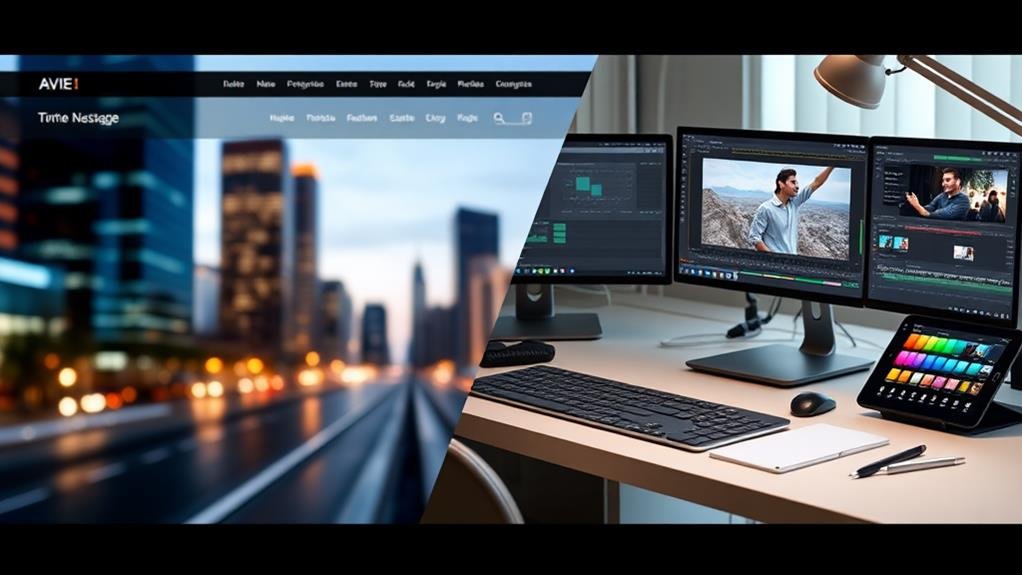
To incorporate video backgrounds effectively, consider the file size and optimize for seamless playback, choosing high-quality, 4K-resolution videos that are relevant to your website's content and audience. Keep it simple, avoiding cluttered or busy videos that distract from your content, and balance audio and video elements to complement each other. Optimize video files for web use, ensuring mobile-friendliness and responsiveness, and test for compatibility issues to guarantee seamless playback. By following these best practices, you'll be well on your way to creating an immersive experience that engages your audience and drives conversions - and there's even more to discover in terms of taking your video backgrounds to new heights.
Benefits of Video Backgrounds
Since you've decided to incorporate video backgrounds into your visual content, you're likely wondering what advantages they bring to the table.
The good news is that video backgrounds can intensify your content in several ways. By leveraging video backgrounds, you can create an immersive experience that engages your audience and sets you apart from static imagery.
In web design, video backgrounds can add a dynamic layer of depth, making your website more interactive and mesmerizing. Moreover, video backgrounds can convey complex information in an easily digestible format, making them perfect for explaining products or services.
They can also evoke emotions and create a lasting impression on your viewers. Moreover, video backgrounds can increase user engagement, reduce bounce rates, and ultimately drive conversions.
With the right implementation, video backgrounds can become a game-changer for your visual content.
When you're looking to augment your visual content with video backgrounds, one crucial decision you'll face is choosing the right video. This choice can make or break the general impact of your website or application.
To choose the right video, consider the file size and optimize it for seamless playback. High-quality, 4K-resolution videos are ideal for a crisp and clear visual experience. However, be mindful of the file size to avoid slow loading times.
Opt for short, loopable videos that are 20-30 seconds long to avoid distractions and maintain viewer engagement. Verify the video is relevant to your website's content and audience to create a cohesive and immersive experience.
You can also consider using 3D animations to add visual interest and create a unique brand identity. Finally, use royalty-free videos or purchase licenses for copyrighted content to avoid legal issues and confirm legitimacy.

Now that you've chosen the right video, it's time to focus on implementing it effectively. To get the most out of your video backgrounds, follow these best practices:
| Principle | Description | Benefits |
|---|---|---|
| Keep it simple | Avoid cluttered or busy videos that distract from your content. | Improves user experience, reduces visual noise |
| Optimize for load times | Compress your video files to prevent slow load times that drive users away. | Faster load times, improved engagement |
| Use video editing techniques | Apply filters, shifts, and color adjustments to augment the visual appeal of your video background. | Augments visual appeal, creates emotional connection |
| Test and iterate | Try out different video backgrounds and analyze their performance to refine your approach. | Improved conversion rates, better user experience |
| Balance audio and video | Verify the audio and video elements complement each other, avoiding overwhelming or distracting the user. | Improved user experience, increased engagement
As you prepare to integrate video backgrounds into your website, it's vital to ponder the technical aspects that can make or break the user experience.
To guarantee seamless playback and peak performance, you'll need to optimize video files for web use by compressing the file size and selecting a compatible format, such as H.264, WebM, or MP4. This will reduce loading times and improve general user experience.
Furthermore, consider using lazy loading to delay the loading of video backgrounds until they come into view, which can improve search engine optimization (SEO) and reduce initial page load time.
Make sure to test your video backgrounds on different devices and browsers to guarantee they're mobile-friendly and responsive, and consider the file size and loading time to prevent slow page loads and high data usage.

With your video backgrounds optimized for web use and technical considerations in check, it's similarly vital to steer clear of common mistakes that can sabotage your efforts.
When using video, it's pivotal to avoid mistakes that can negatively impact user experience. Failing to properly optimize video files for web use can result in slow page loading times, increasing page load time by up to 80%.
Ignoring mobile and tablet users' experiences can also lead to poor video playback and high bounce rates. Not testing video backgrounds for compatibility issues can cause technical issues and poor performance, making 44% of website visitors less likely to return to a website with technical issues.
Moreover, using low-quality or distracting video content can overwhelm users and negatively impact engagement. Besides, overwhelming users with too much video content can lead to sensory overload and negatively impact user experience.
How can you effectively use video backgrounds to augment your website's user experience?
By looking at examples of websites that do it right!
1. Showcase your work: IVS, a cost-effective distributor of videos for publishers and broadcasters, uses a video background on their website to showcase their premium streaming video providers.
In the same way, imotion factory films and Build Films effectively utilize video backgrounds to promote their work in movie and video production.
2. Highlight expertise: PINKANOVA, a production and consultancy company, showcases their experience and expertise with video backgrounds on their website, giving visitors a sense of their capabilities.
3. Emphasize aesthetic: KeepGrading, a post-production video studio, emphasizes color on their website with a beautiful video background, creating a visually appealing experience for users.
These examples demonstrate how video backgrounds can be used to engage users, convey a message, and boost the total web experience.

Nearly 90% of information transmitted to the brain is visual, making video backgrounds a crucial element of website design.
When designing and refining video backgrounds, you must consider several key factors. Initially, select high-quality, 4K-resolution videos and compress them using modern formats like H.264, WebM, and MP4 to reduce file sizes and loading times.
This verifies your video backgrounds load quickly and efficiently, providing a seamless user experience.
To refine your video backgrounds, confirm they're relevant to your website's content and audience.
Consider using 3D animations to create a unique and memorable brand identity. Balance video audio with website audio elements, and use lazy loading to reduce initial page load time, thereby improving user experience and enhancing conversions by up to 20%.
Ultimately, don't forget to refine your video backgrounds for mobile devices, providing alternative static backgrounds and reducing video file sizes to guarantee superior performance across diverse devices.
Optimizing video backgrounds for mobile devices is critical, as unoptimized content can lead to high data usage and slow page load times, ultimately driving users away.
To guarantee a seamless user experience, you need to prioritize mobile optimization.
Some vital techniques to keep in mind:
1. Choose the right video resolution: High-resolution videos can consume excessive data and slow down page loading.
Opt for resolutions that balance quality and file size.
2. Offer alternative static backgrounds: Providing a static background option for mobile devices can dramatically reduce data usage and improve page loading speed.
3. Use modern formats and lazy loading: Techniques like lazy loading and modern formats like H.264 and WebM can reduce file sizes and improve performance, verifying a properly optimized video background that doesn't drain mobile data.

You've optimized your video backgrounds for mobile devices, but now it's time to ponder a critical aspect of user experience: accessibility.
As you design your video backgrounds, make sure to prioritize accessibility to guarantee nothing hinders users from engaging with your website. A perfect background isn't just visually appealing, but also inclusive.
To guarantee accessibility, start by providing good contrast between text and video. This helps users with visual impairments easily read the content on your website.
Next, offer control options like pause, mute, and skip, allowing users to customize their experience according to their needs. Furthermore, provide a non-video alternative to verify that users who can't access video content can still engage with your website.
You'll optimize a video for background by compressing the file size, selecting a compatible format like H.264 or MP4, and adjusting dimensions to match your website's container size, ensuring seamless playback and fast loading times.
You're wondering what's the best format for background videos. Well, you can't go wrong with H.264, which offers a great balance between quality and file size. Alternatively, WebM is a popular, royalty-free option that's similar in quality and performance.
You'll create a good background for a video by keeping it concise, around 20-30 seconds, and ensuring it's relevant to your message. You'll also want to optimize it for web use, considering audio silence and user experience.
You add background effects to a video by using video editing software like Adobe Premiere Pro or DaVinci Resolve, which offer built-in effects and shifts, or by incorporating third-party plugins and templates for more complex customization.
You've made it to the final cut! By now, you've learned how to effectively incorporate video backgrounds into your designs. Remember, it's all about balance, relevance, and technical savvy. With the right video, careful planning, and attention to accessibility, you can create immersive experiences that engage and inspire. So, go ahead, get creative, and make your designs shine with the power of video backgrounds!